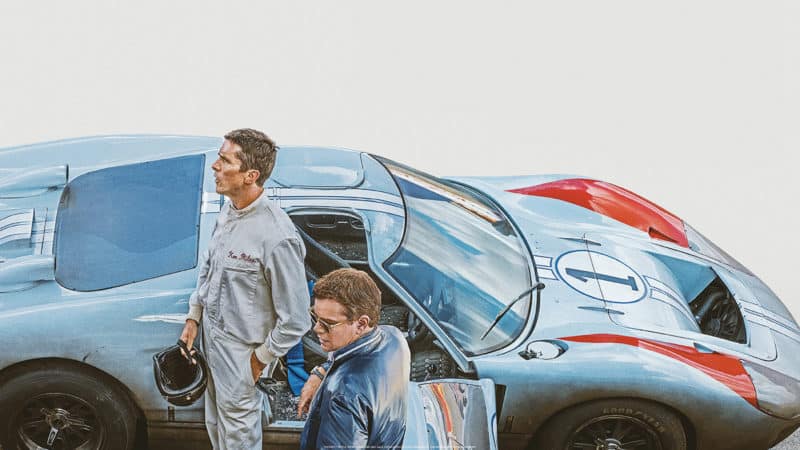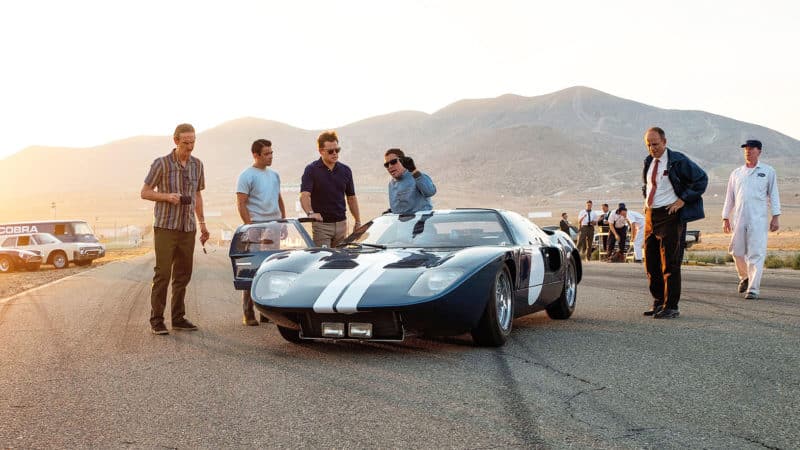Ford v Ferrari: The Epic Story of Shelby, Miles, and the Legendary Race Car
When a development team set about trying to bring motor racing’s biggest grudge match to the silver screen, it turned out to be a slow process. But, almost 10 years after its inception, Ford’s fight with Ferrari for Le Mans glory turned out to be well worth the wait

© twentieth century fox
Although it would prove one of the big hits of 2019, the commercially successful Ford v Ferrari didn’t exactly race to the starting line. The celluloid version of how Carroll Shelby and Ken Miles created a legendary race car had been stalled for almost a decade.
Since 2009, a number of stars and directors – including Brad Pitt, Tom Cruise and Michael Mann – had come and gone from the project. Back then it was called Go Like Hell (from the book by AJ Baime on which it was based: Go Like Hell: Ford, Ferrari, and Their Battle for Speed and Glory at Le Mans).
But it wasn’t until James Mangold got involved in 2018 that things finally began to move forward. The writer/director had just had a critical and commercial hit with Logan, his reimagining of Wolverine as a western. He then helped out significantly on post-production for The Greatest Showman. By year’s end the two films were on their way to earning over a billion dollars for 20th Century Fox, giving Mangold – and Ford v Ferrari, as it was now called — some momentum.
With Mangold on board, Christian Bale agreed to play Miles and Matt Damon took on Shelby. Theatre heavyweight Tracy Letts was hired as Henry Ford II and, with a nine-figure budget in place, the rest of the cast and crew was rounded out with well-regarded talent. The intention was to make a big, old fashioned studio movie.
“It’s the kind of movie that reminds me why I got into the business in the first place,” said über-producer Peter Chernin (Planet of the Apes franchise, Greatest Showman, Red Sparrow, etc). “It’s a big, emotional, distinctive theatrical experience that embraces all of the reasons we want to sit in a movie theatre. We want to be invested. We want to be moved, to cry, to laugh… to be inspired. This movie is all of that and more.”
The real-life events that fuelled the film were indeed inspiring but also bittersweet — a potent mix of stirring and tragic facts that were well known to many race fans. In 1959 Carroll Shelby had won arguably the most challenging race in motorsport, the Le Mans 24 Hours, co-driving (with Englishman Roy Salvadori) an Aston Martin DBR1. But his triumph was soon followed by bad news: the Texan was told that a serious heart condition meant he could never race again.

A total of 34 custom cars were built for Ford v Ferrari to create the racing scenes. This ‘Willow Springs’ race is actually at a Honda test track. Bale (Ken Miles) even trained with pro stunt drivers
©twentieth century fox / Alamy
The resourceful Shelby reinvented himself as a car designer and salesman working out of a warehouse space in Venice Beach with a team that included driver and engineer Ken Miles, a sardonic Brit that the Americans affectionately nicknamed “Teddy Teabag”. Miles became the chief test driver of Shelby-American, and notched up a string of impressive race performances that garnered the attention of the Ford Motor Company which, by the early sixties, had lost its US market leader status to General Motors.
Ford marketing executive Lee Iacocca (who would later revive Chrysler in the ’80s) had proposed a solution: focus on speed. His logic was that if the company had some successful race cars, consumers — particularly a generation of newly affluent young people looking to buy their first cars — would be more inclined to see Ford vehicles as ‘sexy’ by association. Since no-one produced sexier or faster cars than Enzo Ferrari, Ford initially tried to buy its way to racing success by acquiring the company. ‘Il Commendatore’ strung Ford along for a while (whilst actually in negotiations with Fiat) before rejecting Ford in blunt terms when it became clear he wouldn’t retain total autonomy over the racing division after the proposed pairing.
Outraged at the snub, Henry Ford II ordered Ford’s racing division to build a car to defeat Ferrari at Le Mans. Iacocca promptly hired Shelby, who in-turn enlisted Miles.
Which is where we find the centre of Mangold’s film: the engrossing story of how two free-thinking individuals like Shelby and Miles battle corporate thinking, their own personal demons and the laws of physics to develop a revolutionary new race car. But the film also doesn’t skirt away from the high price they pay for their victories.
“The challenge,” said Mangold, “was to navigate this story so that audiences feel the love and camaraderie and energy of these drivers and designers and mechanics and pit crew, but without depending upon a cliché kind of victory. I felt that if we could get deep enough into the characters, the winning and the losing of the races would be secondary to the winning and the losing of their lives.”
The key to Mangold’s film, and what arguably gives Ford v Ferrari its power, is the director’s decision to eschew CG spectacle in favour of a more grounded approach. He said: “In an age of incredibly computer-enhanced action movies, I thought that there could be something analogue and real and gritty about the sexiness of these beasts, the cars, their engines, the danger. These characters are riding in a thin aluminium shell at 200mph. The miracle that was their daring and survival under these circumstances was something that I really wanted to try to convey.”
To that end, Mangold asked his stars to do as much of the driving as they could with real vehicles on real tracks. “It was important because I wanted the audience to feel the vibration of the engine, the bolts rattling in the chassis. To understand how hard the vehicle is being pushed, and how close it is to exploding.”
“I thought that there could be something profoundly analogue and real and gritty about the film and the sexiness of these beasts, the cars, their engines, the danger” James Mangold, director
Cars for the film were built, borrowed or rented. Among them a one-of-a-kind polished aluminium Daytona Coupe, and several historical vehicles that the Automobile Club de l’Ouest loaned from its museum, including a Ford GT40 MKI and an ultra-rare CD SP66 Peugeot. (Only three CD SP66s still exist). Many of the film’s race cars were made by Superformance, while JPS Motorsports in North Hollywood built several Porsche Speedster replicas. In all, 34 custom race cars were built for the film.
Before shooting began, Christian Bale, who drives both a Shelby Cobra and a variety of Ford GT40s on screen, trained with veteran stunt coordinator and driver Robert Nagle. Nagle was impressed: “Christian was very much into it and had a strong aptitude for it. I’d say he’s the best actor I’ve ever trained for driving.”
Naturally, the biggest production challenge was recreating the various racing sequences, up to and including the climactic restaging of the 1966 Le Mans race. But although Le Mans is still an annual event, the current track no longer resembles its 1966 incarnation.
“It looks more like Charles de Gaulle Airport than what it once was, which was a homespun, very simple thing,” said Mangold. “It was a set of country roads connected in a loop with a few quaint grandstands. The magic of that, driving at 200mph in the most cutting-edge race car prototypes on a series of French country roads through day, night, rain, sleet, dawn, dusk—doing that for 24 hours in one vehicle seemed like the most powerful thing we could try to convey.”

Many of the race cars were built by recreation specialist Superformance, with some locations being almost completely redeveloped to resemble a 1960s-spec Circuit de la Sarthe
Like the other races in the film, Le Mans was recreated in the US. (Daytona scenes were filmed at Auto Club Speedway in Fontana, Willow Springs at a Honda test track in Mojave Valley and Dearborn at the Porsche Experience in Carson). The Le Mans sequence featured the largest set constructed for the film: a full-scale historical recreation of the start-finish grandstands, along with three large segments of grandstands, VIP boxes, the Ford and Ferrari pits, and the press box, all of which was built at Agua Dulce Airpark, a private airport in Santa Clarita. In addition, three locations in rural towns in Georgia were used to portray the country road course as it would have looked in 1966, including a stretch of Route 46 in Statesboro, the Grand Prize of America Race Track in Hutchinson Island and Road Atlanta in Braselton. Over five miles of roads were dressed to recreate sections of the Circuit de la Sarthe, such as the Mulsanne Straight, Tertre Rouge, Esses, Arnage and Dunlop Bridge, with hundreds of period-correct banners.
This vast endeavour was essential because, as Mangold observed: “The last 40 minutes of the film is predominantly this race and I really wanted you to feel like you were hunkered down and living in it — I wanted that idea of racing for 24 hours to dawn on you, to feel what that really would be like trying to drive faster than any man for longer than you can stay awake.”
Having spent so much effort recreating the track, the filmmakers also had to devise exactly how they were going to actually film the sequences, with Mangold intent on infusing character into the driving moments. He didn’t want the spectacle to overtake the human drama so opted for a traditional approach. No exaggerated or unnatural camera movements were allowed. The Fast and the Furious, this wasn’t. Instead camera techniques of the period were employed, with both the 1966 sports drama Grand Prix and Steve McQueen’s 1971 film Le Mans serving as references to ensure the focus always remained on the characters.
The thoughtful approach paid off. Audiences flocked to see this analogue film in a digital world. It made over $225 million globally — not bad for a film with no superheroes or Jedis. Critics were equally enamoured. The National Board of Review named it one of the 10 best films of the year and there were BAFTA, Golden Globe and Academy Award nominations, including Best Picture. Ultimately, by embracing the past, Ford v Ferrari isn’t a film that breaks the mould, but it is one that can sit amongst the great racing movies.
